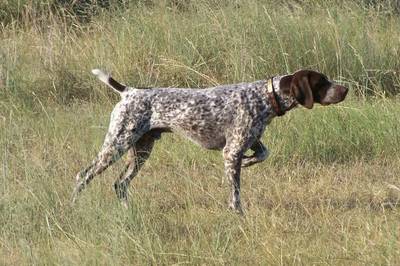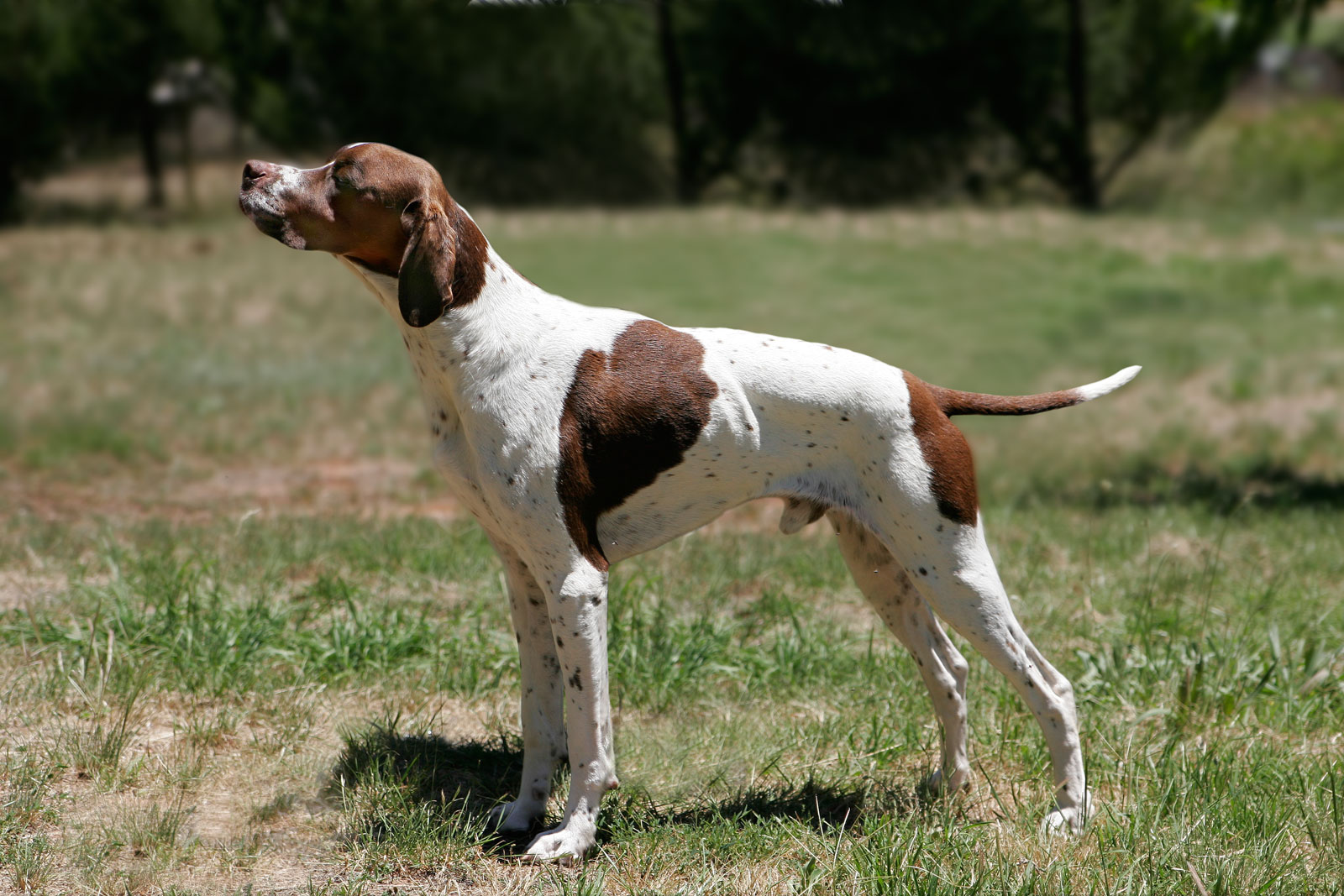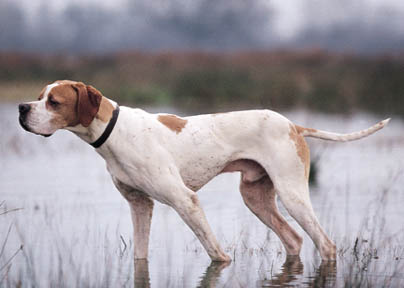
The Breed History
The Pointer, often termed English Pointer is likely the original
pointer-type dog. The Pointer was primarily developed in Britain
though dogs of this general type existed earlier on the Continent,
especially in Portugal and Spain regions (e.g., Italian and Spanish
Pointer). First records in England date to the mid 1600s and
ancestral bloodlines are thought to include Greyhound, Foxhound
and Bloodhound mixed with the primitive setting spaniel dogs.
Spanish, French and German pointer bloodlines were also admixed.
Subsequently, Setter lines were also crossed with Pointers. AKC
recognition occurred in 1884.
Breeding for Function
An on-foot hunt birddog (then subsequently a gundog) was the
primary function for which this breed was developed and refined.
The Pointer was also used to track and set hares for Greyhounds.
During breed development a strong pointing instinct was highly
prioritized. Popular uses today include companion, field trials, and
obedience.
Physical Characteristics
Height at Withers: female 23-26" (58.5-66 cm), male 25-28"
(63.5-71 cm).
Weight: females 45-65 lb (20.5-29.5 kg), males 55-75 lb (25-34 kg).
Coat: The dense, flat laying short glossy hard coat is most
commonly liver and white, though other acceptable colors include
solid liver, black, black and white, and orange, orange and white or
lemon, lemon and white.
Longevity: 13-14 years
Points of Conformation: A lithe, compact, athletic build with
an alert expression, high head carriage, and a powerful elastic
graceful gait characterizes these dogs. They have a well-chiseled
face, a prominent stop, a fairly flat skull with a prominent occipital
protuberance, and slight furrow running between the eyes on the
midline. The muzzle is deep and long, with a slight dishing, eyes
are round, dark and moderately sized. The ears are pendulous
with a moderately pointed tip, velvety hair cover and moderate
leather thickness. The nose pigmentation matches the coat color
and ranges from black through brown to flesh tone. The neck is
long, slightly arched and well muscled. Limbs are straight boned
and long bones are oval in cross section. The thorax is deep, ribs
well sprung, and topline slightly descending towards the rear with
a slight arch though loin and croup. The abdomen is moderately
tucked up. The tapering tail reaches no longer than the tarsus and
is carried slightly above the topline when active. Feet are compact
and oval, have well knuckled up toes. Dewclaws on forelimbs may
be removed.
Recognized Behavior Issues and Traits
Reported breed characteristics include: Adaptable, does well in
kennel, farm or home environments. Not considered an ideal
apartment pet. He has lower needs for human companionship
than many of the other gundogs but if housed inside with the
family, becomes closely attached. Good with children, good alarm
barker, early obedience training and socialization is very important.
A very high energy and activity dog, he needs plenty of exercise
or may become destructive. Possessing an independent will, high
endurance, strong pointing instinct, intelligent, even temperament,
low grooming needs, low shedding tendency, needs to be kept in
during very cold weather.
Normal Physiologic Variations
Echocardiographic Normal Values:
Parameter Mean В± SD
AO (mm) - 24.1 В± 1.7
LA (mm) - 22.6 В± 2.0
LA/AO - 0.94 В± 0.07
LVd (mm) - 39.2 В± 2.4
LVs (mm) - 25.3 В± 2.4
%FS - 35.5 В± 4.0
VSd (mm) - 6.9 В± 1.1
VSs (mm) - 10.6 В± 1.0
LVWd (mm) - 7.1 В± 0.7
LVWs (mm) - 11.5 В± 1.3
Kg - 19.2 В± 2.8
N - 16
HR - 107 В± 17
Drugs - No
AO, aorta; LA, left atrium; LV, left ventricle; FS, fractional shortening;
VS, ventricular septum; VS%О”, change in VS thickness between
diastole and systole; LVW, left ventricular wall; HR, heart rate; N,
number of animals.
In a UK study, 26% of litters were delivered via Cesarean section.
Drug Sensitivities
None reported
Inherited Diseases
Hip Dysplasia: Polygenically inherited trait causing degenerative
joint disease and hip arthritis. OFA reports 8.0% affected.
Elbow Dysplasia: Polygenically inherited trait causing elbow
arthritis. OFA reports 3.1% affected.
Patella Luxation: Polygenically inherited laxity of patellar
ligaments, causing luxation, lameness, and later degenerative joint
disease. Treat surgically if causing clinical signs. Too few Pointers
have been screened by OFA to determine an accurate frequency.
Hereditary Sensory Neuropathy: Rare, autosomal recessive
disorder causing loss of sensation in the toes. Multiple feet can be
involved, and affected dogs severely mutilate their paws.
Spinal Muscle Atrophy: Rare, autosomal recessive disorder
causing weakness and incoordination from 4-6 months of age.
Progresses over a few months to paralysis of all muscles except the
head and tail.
X-Linked Cerebellar Ataxia: Rare, x-linked recessive disorder
causing muscular incoordination, but not muscle weakness.
Affected dogs slowly progress to constant falling.
Deafness: Autosomal recessive deafness is identified in an inbred
research strain of Pointers. It is not known whether this form of
deafness exists in the general population. Congenital deafness can
be unilateral of bilateral. Diagnosed by BAER testing.
Disease Predispositions
Hypothyroidism: Inherited autoimmune thyroiditis. 13.1% positive
for thyroid auto-antibodies based on testing at Michigan State
University. (Ave. for all breeds is 7.5%).
Demodicosis: Dorn reports an 8.52x odds ratio of developing
demodectic mange versus other breeds. This disorder has an
underlying immunodeficiency in its pathogenesis.
Cataracts: Anterior cortex punctate cataracts predominate in the
breed. Identified in 2.14% of Pointers CERF examined by veterinary
ophthalmologists between 2000-2005. CERF does not recommend
breeding any Pointer with a cataract.
Retinal Dysplasia: Focal, folds and geographic retinal dysplasia
occur in the breed. Can lead to blindness. Reported in 1.43% of
Pointers CERF-examined by veterinary ophthalmologists between
2000-2005. CERF does not recommend breeding Pointers with any
form of retinal dysplasia.
Corneal Dystrophy: Pointers can have an epithelial/stromal form of
corneal dystrophy. Identified in 1.43% of Pointers CERF-examined
by veterinary ophthalmologists between 2000-2005.
Abnormal/Lack of Semen, Allergies, Bloat (Gastric Dilitation-
Volvulus), Cancer, Dwarfism, Ectropion/Entropion, Overbite/
Underbite, Seizure Disorders, Skin Disease, and Umbilical
Hernias are reported in the 2002 APC Health and Research Survey.
Black Hair Follicular Dysplasia, Central PRA, Cleft Lip/
Palate, Hypoadrenocorticism, Juvenile Cellulitis, Malignant
Hyperthermia, Pannus, Prognathism, Progressive Retinal
Atrophy, and Subaortic Stenosis are reported.
Isolated Case Studies
Ciliary Dyskinesia: Electron microscopy was used to diagnose
primary ciliary dyskinesia in a litter of English pointer dogs. Affected
dogs present with chronic cough and nasal infection.
Hemangioblastoma: A 6-year-old male Pointer dog was presented
with a 4-week history of progressive hind-limb stiffness. Magnetic
resonance imaging demonstrated a focal intramedullary lesion at
the first thoracic vertebra. Necropsy revealed an intramedullary
hemangioblastoma.
Myoblastoma: A granular cell tumor (GCT; myoblastoma) was
diagnosed on the tongue of a 12-year-old English Pointer with
clinical signs of mild oral dysphagia. Surgical removal was
cruative.
Nervous Pointer Dogs: A family of pathologically "nervous
Pointers" was inbred and established for psychiatric research in the
late 1970s. Affected dogs "freeze" when nervous. This disorder is
not reported in the general population.
Genetic Tests
Tests of Genotype: Direct test for black, liver, lemon, and orange
coat color genes available from VetGen and HealthGene.
Tests of Phenotype: CHIC Certification: Required testing includes
hip radiographs, thyroid profile including autoantibodies, and
CERF eye examination. Optional recommended testing includes
congenital cardiac examination by a specialist, and BAER hearing
test. (See CHIC website; caninehealthinfo.org).
Recommend elbow radiographs and patella evaluation.
Miscellaneous
- Breed name synonyms: English Pointer
- Registries: AKC, UKC as English Pointer, CKC, KCGB (Kennel Club
of Great Britain), ANKC (Australian National Kennel Club), NKC
(National Kennel Club) under English Pointer.
- AKC rank (year 2008): 111 (369 dogs registered)
- Internet resources: American Pointer Club Inc.:
americanpointerclub.org
The Pointer Club (UK): thepointerclub.co.uk/
Pointer Club of Canada:
pawsandeffects.com/PCC/PCC/PCC.html
Photo Gallery of Breed - Pointer - Dog Breed








 Animalia Life
Animalia Life